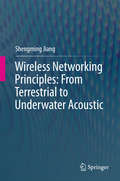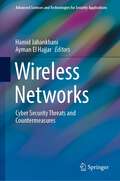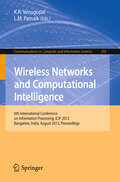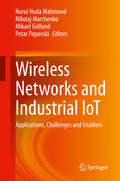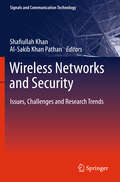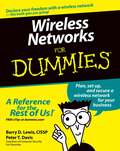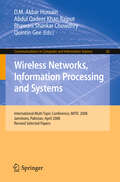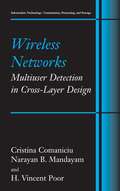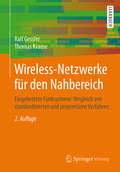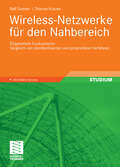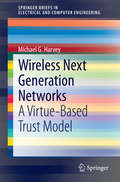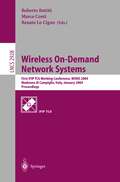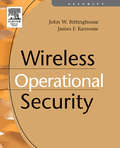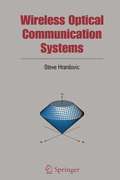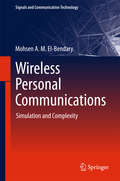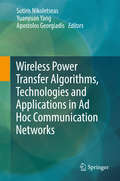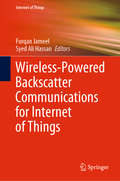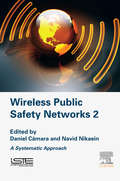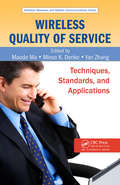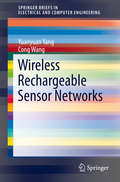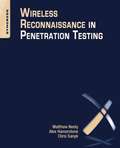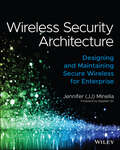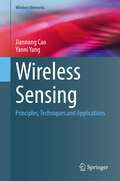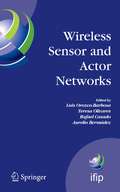- Table View
- List View
Wireless Networking Principles: From Terrestrial to Underwater Acoustic
by Shengming JiangThis book systematically summarizes the fundamentals and various technologies in both terrestrial radio wireless networks and underwater acoustic networks (UWANs). It addresses the basic issues frequently investigated in terrestrial radio wireless networks and the key technologies suitable for the newly developing research area of UWANs. Starting with a review of our current understanding of wireless networks, it then introduces the principles of the main technologies, including error control, medium access control (MAC) protocols, routing protocols, end-to-end transmission control and mobility issues as well as network security for terrestrial radio wireless networks, and offers detailed surveys of these technologies for UWANs.Providing readers with the basic knowledge of terrestrial radio wireless networking technologies and raising readers’ awareness of the developing topic of UWANs in ocean , it is a valuable resource for researchers and practitioners in terrestrial radio wireless networks and UWANs.
Wireless Networks: Cyber Security Threats and Countermeasures (Advanced Sciences and Technologies for Security Applications)
by Hamid Jahankhani Ayman El HajjarIn recent years, wireless networks communication has become the fundamental basis of our work, leisure, and communication life from the early GSM mobile phones to the Internet of Things and Internet of Everything communications. All wireless communications technologies such as Bluetooth, NFC, wireless sensors, wireless LANs, ZigBee, GSM, and others have their own challenges and security threats. This book addresses some of these challenges focusing on the implication, impact, and mitigations of the stated issues. The book provides a comprehensive coverage of not only the technical and ethical issues presented by the use of wireless networks but also the adversarial application of wireless networks and its associated implications. The authors recommend a number of novel approaches to assist in better detecting, thwarting, and addressing wireless challenges and threats. The book also looks ahead and forecasts what attacks can be carried out in the future through the malicious use of the wireless networks if sufficient defenses are not implemented. The research contained in the book fits well into the larger body of work on various aspects of wireless networks and cyber-security. The book provides a valuable reference for cyber-security experts, practitioners, and network security professionals, particularly those interested in the security of the various wireless networks. It is also aimed at researchers seeking to obtain a more profound knowledge in various types of wireless networks in the context of cyber-security, wireless networks, and cybercrime. Furthermore, the book is an exceptional advanced text for Ph.D. and master’s degree programs in cyber-security, network security, cyber-terrorism, and computer science who are investigating or evaluating a security of a specific wireless network. Each chapter is written by an internationally-renowned expert who has extensive experience in law enforcement, industry, or academia. Furthermore, this book blends advanced research findings with practice-based methods to provide the reader with advanced understanding and relevant skills.
Wireless Networks and Computational Intelligence: 6th International Conference on Information Processing, ICIP 2012, Bangalore, India, August 10-12, 2012. Proceedings (Communications in Computer and Information Science #292)
by K. R. Venugopal L. M. PatnaikThis book constitutes the refereed proceedings of the 6th International Conference on Information Processing, ICIP 2012, held in Bangalore, India, in August 2012. The 75 revised full papers presented were carefully reviewed and selected from 380 submissions. The papers are organized in topical sections on wireless networks; image processing; pattern recognition and classification; computer architecture and distributed computing; software engineering, information technology and optimization techniques; data mining techniques; computer networks and network security.
Wireless Networks and Industrial IoT: Applications, Challenges and Enablers
by Nurul Huda Mahmood Nikolaj Marchenko Mikael Gidlund Petar PopovskiThis book provides a comprehensive overview of the most relevant research and standardization results in the area of wireless networking for Industrial IoT, covering both critical and massive connectivity. Most chapters in this book are intended to serve as short tutorials of particular topics, highlighting the main developments and ideas, as well as giving an outlook of the upcoming research challenges.The book is divided into four parts. The first part focuses on challenges, enablers and standardization efforts for reliable low-latency communication in Industrial IoT networks. The next part focuses on massive IoT, which requires cost- and energy-efficient technology components to efficiently connect a massive number of low-cost IoT devices. The third part covers three enabling technologies in the context of Industrial IoT: Security, Machine Learning/Artificial Intelligence and Edge Computing. These enablers are applicable to both connectivity types, critical and massive IoT. The last part covers aspects of Industrial IoT related to connected transportation that are important in, for example, warehouse and port logistics, product delivery and transportation among industries.Presents a comprehensive guide to concepts and research challenges in wireless networking for Industrial IoT;Includes an introduction and overview of such topics as 3GPP standardization for Industrial IoT, Time Sensitive Networking, system dependability over wireless networks, energy-efficient wireless networks, IoT security, ML/AI for Industrial IoT and connected transportation systems;Features contributions by well-recognized experts from both academia and industry.
Wireless Networks and Security: Issues, Challenges and Research Trends (Signals and Communication Technology)
by Shafiullah Khan Al-Sakib Khan Pathan“Wireless Networks and Security” provides a broad coverage of wireless security issues including cryptographic coprocessors, encryption, authentication, key management, attacks and countermeasures, secure routing, secure medium access control, intrusion detection, epidemics, security performance analysis, security issues in applications. The contributions identify various vulnerabilities in the physical layer, MAC layer, network layer, transport layer, and application layer, and focus on ways of strengthening security mechanisms and services throughout the layers. This carefully edited monograph is targeting for researchers, post-graduate students in universities, academics, and industry practitioners or professionals.
Wireless Networks For Dummies
by Barry D. Lewis Peter T. DavisYou’ve probably heard the expression, “It’s time to cut the cord.” Well, it may be time to “cut the cables” at your office and free yourself from your desk and computer. Wireless networks are the waves of the future—literally. Wireless Networks For Dummies guides you from design through implementation to ongoing protection of your system and your information so you can: Remain connected to the office in airports and hotels Access the Internet and other network resources in the lunchroom, conference room, or anywhere there’s an access point Use your PDA or laptop to query your database from the warehouse or the boardroom Check e-mail wirelessly when you’re on the road Get rid of the cable clutter in your office Wireless Networks For Dummies was coauthored by Barry D. Lewis, CISSP, and Peter T. Davis, who also coauthored Computer Security For Dummies. Barry Lewis is president of an information security consulting firm and an internationally known leader of security seminars. Peter Davis is founder of a firm specializing in the security, audit, and control of information. Together, they cut through the cables, clutter, and confusion and help you: Get off to a quick start and get mobile with IrDA (Infrared Data Association) and Bluetooth Perform a site survey and select the right standard, mode, access point, channel and antenna Check online to verify degree of interoperability of devices from various vendors Install clients and set up roaming Combat security threats such as war driving, jamming, hijacking, and man-in-the-middle attacks Implement security and controls such as MAC (Media Access Control) and protocol filtering, WEP (Wireless Equivalent Privacy), WPA, (Wi-Fi Protected Access), EAP (Extensible Authentication Protocol), and VPN (Virtual Private Network) Set up multiple access points to form a larger wireless network Complete with suggestions of places to get connected, Web sites where you can get more information, tools you can use to monitor and improve security, and more, Wireless Networks For Dummies helps you pull the plug and go wireless!
Wireless Networks Information Processing and Systems: First International Multi Topic Conference, IMTIC 2008 Jamshoro, Pakistan, April 11-12, 2008 Revised Papers (Communications in Computer and Information Science #20)
by Dil Muhammad Akbar Hussain Abdul Qadeer Khan Rajput Bhawani Shankar Chowdhry Quintin GeeThe international multi-topic conference IMTIC 2008 was held in Pakistan during April 11–12, 2008. It was a joint venture between Mehran University, Jamshoro, Sindh and Aalborg University, Esbjerg, Denmark. Apart from the two-day main event, two workshops were also held: the Workshop on Creating Social Semantic Web 2.0 Information Spaces and the Workshop on Wireless Sensor Networks. Two hundred participants registered for the main conference from 24 countries and 43 papers were presented; the two workshops had overwhelming support and over 400 delegates registered. IMTIC 2008 served as a platform for international scientists and the engineering community in general, and in particular for local scientists and the engineering c- munity to share and cooperate in various fields of interest. The topics presented had a reasonable balance between theory and practice in multidisciplinary topics. The c- ference also had excellent topics covered by the keynote speeches keeping in view the local requirements, which served as a stimulus for students as well as experienced participants. The Program Committee and various other committees were experts in their areas and each paper went through a double-blind peer review process. The c- ference received 135 submissions of which only 46 papers were selected for presen- tion: an acceptance rate of 34%.
Wireless Networks: Multiuser Detection in Cross-Layer Design (Information Technology: Transmission, Processing and Storage)
by Christina Comaniciu Narayan B. Mandayam H. Vincent PoorCross-layer design seeks to enhance the capacity of wireless networks significantly through the joint optimization of multiple layers in the network, primarily the physical (PHY) and medium access control (MAC) layers. Although there are advantages of such design in wireline networks as well, this approach is particularly advantageous for wireless networks due to the properties (such as mobility and interference) that strongly affect performance and design of higher layer protocols. This unique monograph is concerned with the issue of cross-layer design in wireless networks, and more particularly with the impact of node-level multiuser detection on such design. It provides an introduction to this vibrant and active research area insufficiently covered in existing literature, presenting some of the principal methods developed and results obtained to date. Accompanied by numerous illustrations, the text is an excellent reference for engineers, researchers and students working in communication networks.
Wireless-Netzwerke für den Nahbereich: Eingebettete Funksysteme: Vergleich von standardisierten und proprietären Verfahren
by Ralf Gessler Thomas KrauseNach der Einführung des Global System for Mobile Communications (GSM) und später Wireless LAN sind die Wireless-Netzwerke für den Nahbereich die nächste Entwicklungsstufe der drahtlosen Kommunikation. Die Autoren vermitteln Grundlagen der Nachrichten- und Kommunikationstechnik sowie Eingebetteter Systeme, um dann moderne Funkübertragungsverfahren miteinander zu vergleichen. Auch die Implementierung von Eingebetteten Funksystemen wird dargestellt. Das Buch liefert damit eine Grundlage für sinnvolle technische und ökonomische Entscheidungen.
Wireless-Netzwerke für den Nahbereich: Eingebettete Funksysteme: Vergleich von standardisierten und proprietären Verfahren
by Ralf Gessler Thomas KrauseDieses Buch dient als technische und ökonomische Entscheidungshilfe. Es liefert Grundlagen aus den Gebieten Nachrichten-, Kommunikationstechnik und Eingebettete Systeme und erarbeitet daraus wichtige Parameter („Stellschrauben“) für den Vergleich. Die einzelnen standardisierten Verfahren wie Bluetooth, ZigBee, WLAN und weitere proprietäre Verfahren werden anhand des ISO/OSI-Modells als zentralem Ordnungselement vorgestellt. Das Buch liefert in Theorie und Praxis eine durchgehende und vollständige Darstellung der Implementierung von Eingebetteten Funksystemen. Beispiele, Aufgaben, Einstiegshilfen und Literaturhinweise zur weiteren Vertiefung runden das Werk ab.
Wireless Next Generation Networks: A Virtue-Based Trust Model (SpringerBriefs in Electrical and Computer Engineering)
by Michael G. HarveyThis SpringerBrief proposes a trust model motivated by virtue epistemology, addressing the need for a more efficient and flexible trust model for wireless next generation networks. This theory of trust simplifies the computation and communication overhead of strictly cognitive-computational models of trust. Both the advantages and the challenges of virtue-based trust models are discussed. This brief offers new research and a general theory of rationality that enables users to interpret trust and reason as complementary mechanisms that guide our rational conduct at two different epistemic levels. The presented model of human social interaction is designed for the highly dynamic and unstructured environment of the mobile Internet and wireless next generation networks. Wireless Next Generation Networks: A Virtue-Based Trust Model targets network engineers, cognitive scientists, AI researchers, philosophers, and social scientists. Advanced-level students studying computer science, electrical engineering and social science will also find the interdisciplinary perspective useful.
Wireless On-Demand Network Systems: First IFIP TC6 Working Conference, WONS 2004, Madonna di Campiglio, Italy, January 21-23, 2004, Proceedings (Lecture Notes in Computer Science #2928)
by Roberto Battiti Marco Conti Renato Lo CignoThisbookcontainstherefereedproceedingsofthe1stIFIP-TC6WorkingCon- rence on Wireless-On-Demand Network Systems, WONS 2004. It was sponsored by the IFIP Working Groups 6.3 (Performance of Computer and Commu- cation Networks)and6.8(Mobile and Wireless Communications), and aimed at becoming a premier international forum for discussions between researchers and practitioners interested in the evolution of Wireless Internet Access toward on-demand networking. Ad hoc, routing, localization, resource management, - curity, applications, performance and analytical models were topics covered in depth by technical papers in this book. Theconferencereceived77submissionsfrom22countries,showingthewor- wide interest. With so many papers to choose from, the Technical Program Committee’s job, providing a conference program with the highest quality, was challenging and time consuming. We ?nally selected 25 full papers for presen- tion in the conference technical sessions. To give researchers the opportunity to present the novel ideas they are starting to explore, we included in the technical program a poster session devoted to presenting preliminary research results: 7 short papers were selected for presentation in this session. Accepted papers and posters came from 15 di?erent countries. The technical program also included a keynote speech “Ad Hoc Wireless Networks: Protocols and Applications” by Prof. Mario Gerla, and a panel s- sion devoted to the discussion of the conference topics between academics and industry representatives. This event would not have been possible without the enthusiasm and hard work of a number of colleagues. A special thanks to the TPC members, and all the referees, for their invaluable help in reviewing the papers for WONS 2004.
Wireless Operational Security
by John Rittinghouse, PhD, CISM James F. Ransome, PhD, CISM, CISSPThis comprehensive wireless network book addresses the operational and day-to-day security management requirements of 21st century companies. Wireless networks can easily be reconfigured, are very mobile, allow for potentially nonstop exposure, and require the level of security be scrutinized even more than for wired networks. This includes inherent security flaws in various wireless architectures that result in additional risks to otherwise secure converged wired networks. An even worse scenario is one where an insecure wireless network is connected to a weakly secured or insecure wired network and the wireless subnet is not separated from the wired subnet. There are approximately a dozen popular books that cover components of the architecture, design, theory, issues, challenges, and recommended policies for wireless security, none of which address them in a practical, operationally-oriented and comprehensive way. Wireless Operational Security bridges this gap.*Presents a new "WISDOM" model for Wireless Security Infrastructures*Acts as a critical guide to implementing "Converged Networks" wired/wireless with all necessary security considerations*Rittinghouse's Cybersecurity Operations Handbook is the only security book recommended by the FCC
Wireless Optical Communication Systems
by Steve HranilovicThis volume addresses the problem of designing efficient signalling and provides a link between the areas of communication theory and modem design for amplitude constrained linear optical intensity channel. It provides practical guidelines for the design of signalling sets for wireless optical intensity channels.
Wireless Personal Communications: Simulation and Complexity (Signals and Communication Technology)
by Mohsen A. M. El-BendaryThis book introduces wireless personal communications from the point of view of wireless communication system researchers. Existing sources on wireless communications put more emphasis on simulation and fundamental principles of how to build a study model. In this volume, the aim is to pass on to readers as much knowledge as is essential for completing model building of wireless communications, focusing on wireless personal area networks (WPANs). This book is the first of its kind that gives step-by-step details on how to build the WPANs simulation model. It is most helpful for readers to get a clear picture of the whole wireless simulation model by being presented with many study models. The book is also the first treatise on wireless communication that gives a comprehensive introduction to data-length complexity and the computational complexity of the processed data and the error control schemes. This volume is useful for all academic and technical staff in the fields of telecommunications and wireless communications, as it presents many scenarios for enhancing techniques for weak error control performance and other scenarios for complexity reduction of the wireless data and image transmission. Many examples are given to help readers to understand the material covered in the book. Additional resources such as the MATLAB codes for some of the examples also are presented.
Wireless Power Transfer Algorithms, Technologies and Applications in Ad Hoc Communication Networks
by Sotiris Nikoletseas Yuanyuan Yang Apostolos GeorgiadisThis book is the first systematic exposition on the emerging domain of wireless power transfer in ad hoc communication networks. It selectively spans a coherent, large spectrum of fundamental aspects of wireless power transfer, such as mobility management in the network, combined wireless power and information transfer, energy flow among network devices, joint activities with wireless power transfer (routing, data gathering and solar energy harvesting), and safety provisioning through electromagnetic radiation control, as well as fundamental and novel circuits and technologies enabling the wide application of wireless powering. Comprising a total of 27 chapters, contributed by leading experts, the content is organized into six thematic sections: technologies, communication, mobility, energy flow, joint operations, and electromagnetic radiation awareness. It will be valuable for researchers, engineers, educators, and students, and it may also be used as a supplement to academic courses on algorithmic applications, wireless protocols, distributed computing, and networking.
Wireless-Powered Backscatter Communications for Internet of Things (Internet of Things)
by Furqan Jameel Syed Ali HassanThis book provides and assesses the techniques required for the realization of practical wireless-powered backscatter systems for large-scale and intelligent IoT networks. It explores the deployment, reliability, and security aspects of backscatter devices for both indoor and outdoor environments. The book also sheds light on some of the recently evolving technologies such as artificial intelligence/ machine learning, non-orthogonal multiple access (NOMA), and multi-tone carrier techniques and identifies their application in backscatter communications. In addition, it offers a valuable blueprint for future studies in the domains of intelligent reflective surfaces, ambient backscatter communications and massive IoT networks.
Wireless Public Safety Networks 2: A Systematic Approach
by Daniel Câmara Navid NikaeinWireless Public Safety Networks, Volume Two: A Systematic Approach presents the latest advances in the wireless Public Safety Networks (PSNs) field, the networks established by authorities to either prepare the population for an eminent catastrophe, or those used for support during crisis and normalization phases. Maintaining communication capabilities in a disaster scenario is crucial for avoiding loss of lives and damages to property. This book examines past communication failures that have directly contributed to the loss of lives, giving readers in-depth discussions of the public networks that impact emergency management, covering social media, crowdsourcing techniques, wearable wireless sensors, moving-cells scenarios, mobility management protocols, 5G networks, broadband networks, data dissemination, and the resources of the frequency spectrum. Provides a focus on specific enabling technologies which can help the most on the deployment and usage of PSNs in real world scenariosProposes a general framework that has the capability to fulfill the public safety requirements and dynamically adapt to different public safety situationsInvestigates the problem of data dissemination over PSNs, presenting a review of the state-of-the-art of different information and communication technologies
Wireless Quality of Service: Techniques, Standards, and Applications
by Maode Ma Mieso K. DenkoFocusing on an important and complicated topic in wireless network design, Wireless Quality of Service: Techniques, Standards, and Applications systematically addresses the quality-of-service (QoS) issues found in many types of popular wireless networks. In each chapter, the book presents numerous QoS challenges encountered in real-world
Wireless Rechargeable Sensor Networks (SpringerBriefs in Electrical and Computer Engineering)
by Yuanyuan Yang Cong WangThis SpringerBrief provides a concise guide to applying wireless energy transfer techniques in traditional battery-powered sensor networks. It examines the benefits and challenges of wireless power including efficiency and reliability. The authors build a wireless rechargeable sensor networks from scratch and aim to provide perpetual network operation. Chapters cover a wide range of topics from the collection of energy information and recharge scheduling to joint design with typical sensing applications such as data gathering. Problems are approached using a natural combination of probability theory, optimization, algorithm and protocol designs. All proposed mechanisms are evaluated by extensive simulations. Wireless Rechargeable Sensor Networks targets professionals and researchers working in networks, wireless communications, energy technology and information technology. Advanced-level students studying electrical engineering and computer science will also find this material useful as a study guide.
Wireless Reconnaissance in Penetration Testing
by Matthew Neely Alex Hamerstone Chris SanykIn many penetration tests, there is a lot of useful information to be gathered from the radios used by organizations. These radios can include two-way radios used by guards, wireless headsets, cordless phones and wireless cameras. Wireless Reconnaissance in Penetration Testing describes the many ways that a penetration tester can gather and apply the information available from radio traffic. Stopping attacks means thinking like an attacker, and understanding all the ways that attackers gather information, or in industry terms profile, specific targets. With information from what equipment to use and how to find frequency information, to tips for reducing radio information leakage, to actual case studies describing how this information can be used to attack computer systems, this book is the go-to resource for penetration testing and radio profiling. Author Matthew Neely is a respected and well-known expert and speaker on radio reconnaissance and penetration testingIncludes real-world case studies of actual penetration tests using radio profilingCovers data leakage, frequency, attacks, and information gathering
Wireless Security Architecture: Designing and Maintaining Secure Wireless for Enterprise
by Jennifer MinellaReduce organizational cybersecurity risk and build comprehensive WiFi, private cellular, and IOT security solutions Wireless Security Architecture: Designing and Maintaining Secure Wireless for Enterprise offers readers an essential guide to planning, designing, and preserving secure wireless infrastructures. It is a blueprint to a resilient and compliant architecture that responds to regulatory requirements, reduces organizational risk, and conforms to industry best practices. This book emphasizes WiFi security, as well as guidance on private cellular and Internet of Things security. Readers will discover how to move beyond isolated technical certifications and vendor training and put together a coherent network that responds to contemporary security risks. It offers up-to-date coverage—including data published for the first time—of new WPA3 security, Wi-Fi 6E, zero-trust frameworks, and other emerging trends. It also includes: Concrete strategies suitable for organizations of all sizes, from large government agencies to small public and private companies Effective technical resources and real-world sample architectures Explorations of the relationships between security, wireless, and network elements Practical planning templates, guides, and real-world case studies demonstrating application of the included conceptsPerfect for network, wireless, and enterprise security architects, Wireless Security Architecture belongs in the libraries of technical leaders in firms of all sizes and in any industry seeking to build a secure wireless network.
Wireless Security Architecture: Designing and Maintaining Secure Wireless for Enterprise
by Jennifer MinellaReduce organizational cybersecurity risk and build comprehensive WiFi, private cellular, and IOT security solutions Wireless Security Architecture: Designing and Maintaining Secure Wireless for Enterprise offers readers an essential guide to planning, designing, and preserving secure wireless infrastructures. It is a blueprint to a resilient and compliant architecture that responds to regulatory requirements, reduces organizational risk, and conforms to industry best practices. This book emphasizes WiFi security, as well as guidance on private cellular and Internet of Things security. Readers will discover how to move beyond isolated technical certifications and vendor training and put together a coherent network that responds to contemporary security risks. It offers up-to-date coverage—including data published for the first time—of new WPA3 security, Wi-Fi 6E, zero-trust frameworks, and other emerging trends. It also includes: Concrete strategies suitable for organizations of all sizes, from large government agencies to small public and private companies Effective technical resources and real-world sample architectures Explorations of the relationships between security, wireless, and network elements Practical planning templates, guides, and real-world case studies demonstrating application of the included conceptsPerfect for network, wireless, and enterprise security architects, Wireless Security Architecture belongs in the libraries of technical leaders in firms of all sizes and in any industry seeking to build a secure wireless network.
Wireless Sensing: Principles, Techniques and Applications (Wireless Networks)
by Jiannong Cao Yanni YangThis book systematically presents the wireless sensing technology, which has become a promising sensing paradigm in recent years. It includes the introduction of underlying sensing principles, wireless signals, sensing methodologies and enabled applications. Meanwhile, it provides case studies to demonstrate how wireless sensing is applied for representative human and object sensing applications.This book also provides a wireless sensing framework as a guidance to understand and design a wireless sensing system or prototype based on their needs. It also presents a critical investigation of the challenges in achieving wireless sensing in both signal-level and application-level contexts. Accordingly, it summarizes the typical solutions to tackle the related challenges.Researchers and advanced-level students in computer science or electrical engineering working on the design of a wireless system will find this book useful as a reference. Professionals working in the wireless sensing industry will also find this book valuable as a reference tool.
Wireless Sensor and Actor Networks: IFIP WG 6.8 First International Conference on Wireless Sensor and Actor Networks, WSAN'07, Albacete, Spain, September 24-26, 2007 (IFIP Advances in Information and Communication Technology #248)
by Luis Orozco-Barbosa Teresa Olivares Rafael Casado Aurelio BermúdezThis book presents the proceedings of the first IFIP WG 6.8 conference on Wireless Sensor and Actor Networks held in Albacete, Spain. The papers selected to be included in this volume illustrate the state-of-the-art and current trends in the area of wireless sensor and actor networks. The comprehensive program was organized into eight topics: Actors; Applications; Security; Energy; Quality of Service; Localization; Middleware; Protocols.
